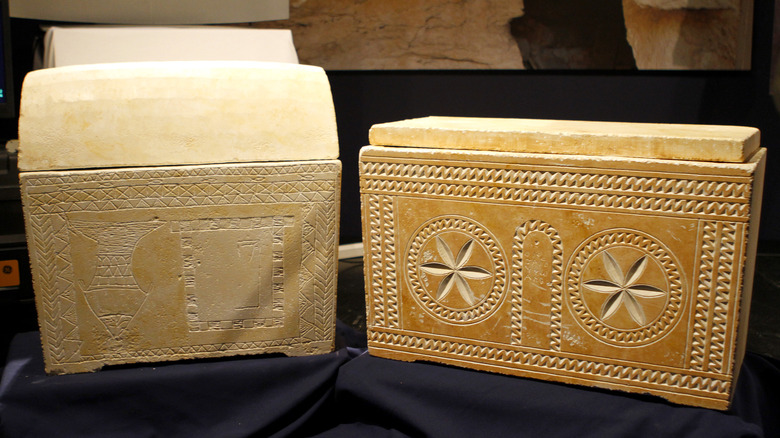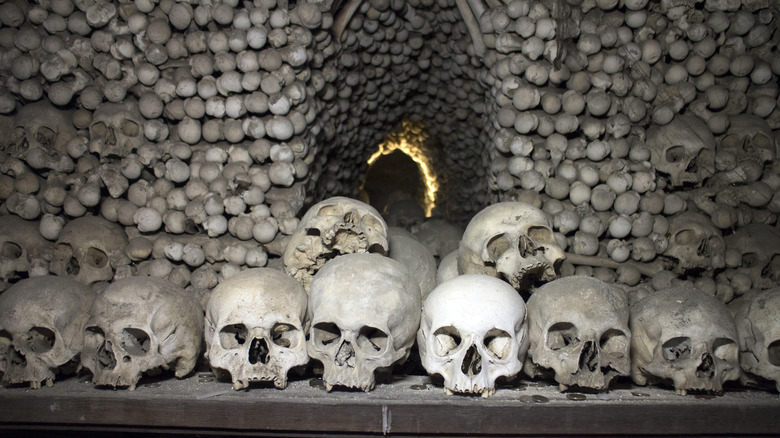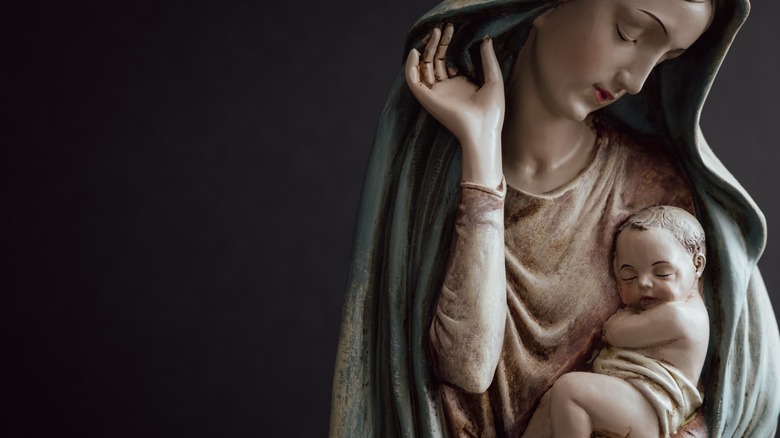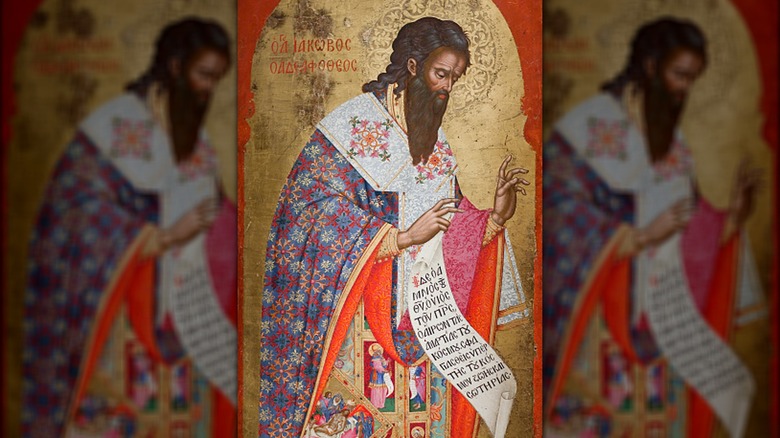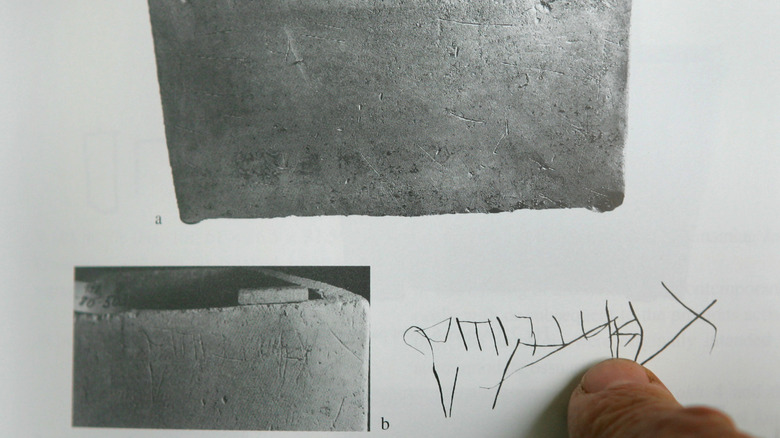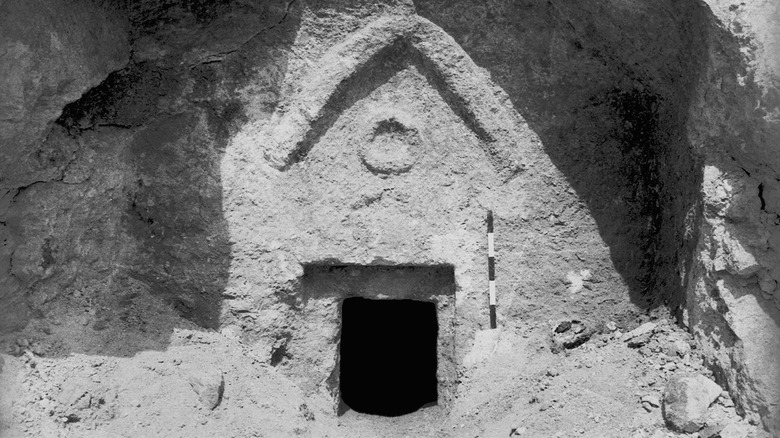The History Of The James Ossuary And Its Possible Connection To Jesus Explained
As long as people have told Jesus' story, they've looked for evidence of his life. Many people might know about the Shroud of Turin, for instance, the fabric supposedly imprinted with the outline of his face and body (a theory that would change everything). Debunked as a hoax as far back as 1354 C.E., it persisted in cultural memory until modern scientific tests discredited it again in 1988. Then there's the True Cross on which Jesus was crucified, supposedly discovered in 326 C.E. For centuries, the fragments circulated as novelty purchases for pilgrims. These are just two examples of many artifacts allegedly related to Jesus' life.
Much more recently, in 2002, another artifact came to light. Though it seems rather dull on the surface, it could rewrite the entire Christian narrative. That is, if it's real (spoiler: this is still up for debate). Back then, Israeli antiquities collector Oded Golan brought to the public a limestone box that he'd had in his possession since 1976. It had some engravings on the outside, including something that looked like a little fish picture. More to the point, it was an ossuary: A container for the bones of the dead. And on the side read an inscription in Aramaic: "James, son of Joseph, brother of Jesus."
There was a media flurry at the ossuary's initial unveiling in Toronto, Canada, and a subsequent seven-year-long forgery investigation into Golan. The ossuary became the subject of intense scientific scrutiny. It was also a sticking point for Catholics and Protestants regarding the Virgin Mary's supposed lifelong virginity.
Jewish burial practices and ossuaries
In general, ossuaries are just containers for the dead. They can be everything from above-ground rooms to small containers to whole structures like churches. They can also be used as secondary storage locations if a cemetery starts to get too full. And of course, traditions vary from culture to culture over the entirety of human history. When considering that the James Ossuary might contain the remnants of James, the brother of Jesus, we've got to look at Jewish burial practices in the province of Judea within the Roman Empire, circa the life and times of Jesus.
Jewish burial customs changed quite a bit over their entire, multi-thousand-year history. But by the time we get to the 1st century B.C.E through the 1st century C.E. — within the Second Temple Period — Jewish burial customs included what we find in the Bible's New Testament following Jesus' death by crucifixion. A body was wrapped, maybe put in a wooden coffin, placed in a big stone cave, and a year later the bones removed and deposited into an ossuary like the James Ossuary. This was known as a "secondary burial." Burial real estate was limited at the time of Jesus, which lent itself to this practice.
Ossuaries themselves were about 2.5 feet long and chiseled with a variety of designs like rosettes, flowers, wavy lines, etc. Sometimes they were engraved with inscriptions explaining who was housed within, and sometimes they were stored with the ossuaries of other family members — a point critical to the history of the James Ossuary.
The ossuary is a point of Catholic/Protestant contention
It's doubtful that the James Ossuary could ever "prove" anything about Jesus, his life, his works, etc. But it could at least be taken as evidence that biblical texts are accurate when they say that he had siblings. For instance, Mark 3 says, "Then Jesus' mother and brothers arrived." Earlier in the chapter it even says that Jesus' family thought he was experiencing mental illness with the whole messianic preaching thing, saying, "When his family heard about this, they went to take charge of him, for they said, 'He is out of his mind.'"
This issue of whether or not Jesus had any fully human, non-deified siblings has been a bone of contention amongst Christian circles since the Catholic Church's early days. Catholic Answers explains that the institution officially abides by an "Ever-virgin" policy regarding Mary. Notably, it interprets verses about Jesus' "brothers" and "sisters" as having a kind of fraternal, universal "brothers in Christ" meaning. This has been the case since Pope Martin I built on 553 C.E.'s Second Council of Constantinople and decreed that Mary was a literal virgin her entire life — before, during, and after Jesus' birth.
The Catholic Thing says that early Protestants, including Martin Luther and John Calvin, were at least willing to go alone with the Catholic "Ever-virgin" policy. Over time, though, this view changed. Nowadays, Protestants by and large believe that Mary couldn't have stayed a virgin if Jesus had siblings.
The bones of James the Just
Given its inherently contentious status, very few people were ever going to take the James Ossuary's authenticity at face value. Even if it came from the time period in question — the 1st-century B.C.E. to 1st-century C.E. — many doubted the "James, son of Joseph, brother of Jesus" inscription. These skeptics claimed that it could have very easily been forged after-the-fact. As far as the James on the inscription is concerned, Galatians 1:19 names him "the Lord's brother." After his death in 62 C.E., he was dubbed "the Just" for his refusal to deviate from certain Jewish laws after converting to Christianity.
The ossuary's Israeli owner Oded Golan, however, knew nothing about James the Just or the box's relevance. As the Biblical Archaeology Society explains, he bought the ossuary off a random antiquities dealer in the mid-70s for a few hundred bucks and held onto it for decades. His main motivation for putting it on display was to attract attention and learn more about it.
Golan revealed the ossuary to the public after showing it to epigraphist André Lemaire at a party in 2001. The inscription expert read the Aramaic on the box, and in 2002, he published his now-infamous article in Bible Archaeology Review stating that the inscription read, "James, son of Joseph, brother of Jesus." The ossuary drew criticism and controversy after its initial reveal at the Royal Ontario Museum on November 10, right down to a botched delivery that left it with some new cracks.
Accusations of forgeries
It didn't take long for Christians of either stripe to denounce or laud the James Ossuary. In 2003, one year after its public debut, the Israeli Antiquities Authority (IAA) set about determining the truth of the limestone box and concluded it was a fake. A long criminal trial against owner Oded Golan began the next year, where he faced charges of forgery. The proceedings lasted until 2012 and saw Golan ultimately acquitted of all forgery charges but convicted of other minor offenses related to unlicensed antiquities dealing. The James Ossuary, though? The litigation sidestepped issues of its authenticity altogether.
The trial involved a ridiculously convoluted series of events. Examples included the prosecution being underfunded, the defense strutting out "scientists" of dubious expertise, a U.S.-based lawyer attacking the IAA's initial research into the ossuary, and claims from a Tel Aviv University academic about the artifact's patina (outer coating) being made out of modern "James Bond"-like materials. There was even an unknown Egyptian claiming to have made fake artifacts for Golan, but he couldn't be pressured to testify in court because of the complexities of Arab-Israeli relations.
Ultimately, per the Los Angeles Times, Jerusalem judge Aharon Farkash said that "the prosecution failed to prove beyond all reasonable doubt ... that the ossuary is a forgery and that Mr. Golan or someone acting on his behalf forged it." He added, "This is not to say that the inscription on the ossuary is true and authentic and was written 2,000 years ago."
The Jesus family tomb
Before Oded Golan's forgery trial came to a close, a very well-timed documentary came out in 2007 that added another layer of complications to proceedings. Dubbed "The Lost Tomb of Jesus" and produced by James Cameron, the documentary explores a tomb in Talpiot, Jerusalem that some claim was the "Jesus family tomb" (pictured above). Containing 10 ossuaries inscribed with familiar biblical names like "Jesus," "Mary," and "Joseph," geologist Aryeh Shimron said that chemical analyses dating to a 363 C.E. earthquake revealed that the James Ossuary came from this exact burial chamber.
The documentary had little impact on Golan's trial, and the James Ossuary went back to him in 2013. A study from the Geological Survey of Israel published the following year analyzed the patina of the ossuary and determined that factors like the quartz layer inside it "reinforces the authenticity of the inscription." Another study from 2017, however, in the Journal of Historical Archaeology & Anthropological Sciences, examined the patina and inscription and concluded that the "brother of Jesus" section was added later.
Recently, in 2023, the James Ossuary popped up as part of a holographic light-and-video exhibit called "The Nazarene — The Way, the Truth, the Life." The Dallas-based display is set to expand to cities across the U.S. Creator Alpine Artists told Jerusalem Post the exhibit lasts about one hour. "If you are viewing the artifact exhibit [the James Ossuary] as well, plan to stay for an additional 30 minutes," they said. "And don't forget to allow time to browse the gift shop."
